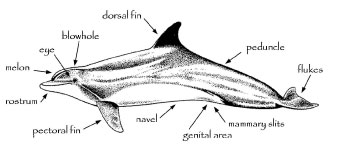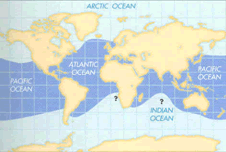Natural History of Dolphins

Marine Mammals
In the animal kingdom there are many different groups or "classes" such as reptiles, birds, amphibians and mammals. All mammals have five characteristics in common:
- Warm-blooded
- Breath air
- Give birth to live young
- Born with hair
- Nurse their young
 Porpoise
Porpoise
Dolphins are one of many marine mammals that inhabit the sea, others being manatees, otters, sea lions and whales. All the whales, dolphins and porpoises belong to the order called Cetacea, which can be further divided into three smaller groups known as suborders. The Archeocetes were the ancient whales and are now extinct. The second group, the Mysticetes, include, among others, the gigantic blue, grey and humpback whales. Members of this suborder have two blowholes and instead of teeth, have a series of comb-like plates called baleen which they use to strain plankton and shrimp from the water as a food source.
The largest suborder is the Odontocetes, also known as the toothed whales which includes groups such as the sperm whales, belugas and dolphins. The number of teeth may vary with the species, but all use their teeth for catching, not chewing, their food. There are ten different families of toothed whales.
 Dolphin
Dolphin Though many people often confuse the two, dolphins and porpoises are different families of toothed whales. Divided into six different species, porpoises are generally smaller than dolphins, darker in color, and found in deeper and cooler waters. Porpoises usually lack the rostrum or "bottlenose" that most dolphins have. Another distinct trait of porpoises is their teeth: they have flat, spade-shaped teeth versus the conical-shaped teeth of dolphins.
Finally, there are about thirty species of dolphins found in our oceans, a few being the white-sided, spotted and bottlenose. It is the Atlantic bottlenose dolphin, Tursiops truncatus, that is most well known to people. These animals tend to live in the shallow waters in which people frequently choose to swim and boat. This species of dolphin also does very well under human care and are usually your marine park performers.
The Atlantic Bottlenose Dolphin
 Bottlenose dolphins are found in temperate waters (royal blue) throughout the world.
Bottlenose dolphins are found in temperate waters (royal blue) throughout the world.
The Atlantic bottlenose dolphin can be found throughout the temperate, tropical and sub-tropical waters of the Atlantic Ocean. With a great deal of variety in size, appearance and behaviors, these dolphins are further divided into approximately nine different sub-species. For example, the bottlenose dolphins off the United Kingdom may weigh up to 1200 pounds and migrate short distances to locate food or evade predators. In the shallow Bahamian waters, Atlantic bottlenose dolphins grow up to nine feet in length weighing up to 500 pounds. Average lifespan for this species in the wild is approximately 25 years.
Research confirms that these animals currently live equally as long under human care and, in many cases, live longer, healthier lives than their counterparts in the wild. In marine parks and aquariums, dolphins are protected from the dangers of pollution, predators, and events such as El Nino, which triggered food shortages for many marine mammals in the late 1990's. The oldest dolphin under human care lived to be 54 years of age. Due to public display, advances in animal care and medicine have greatly contributed to the improved health of cetaceans under human care, as well as to the successful rehabilitation and release of stranded, injured animals.
As mammals like us, dolphins are born with hair but where is the hair located? It was on top of the rostrum, the bony extension of their skull used to touch and move objects, but the few hairs usually fall out just before the calf is born or shortly thereafter. In general dolphins are well known for their bottlenose or rostrum with the built-in smile. The rostrum is a bony extension of their skull used to touch and move objects since they don't have hands.
Inside the dolphin's mouth, you will find 76 to 98 conically-shaped teeth used for defense or to grab their prey, which is then swallowed whole. As far as diet, these dolphins are known as "catholic" feeders, eating whatever fish species is locally available. Primarily they eat schooling fish - herring, mackerel, mullet or capelin to name a few - but also some crustaceans and molluscs, such as squid or shrimp.
Where do dolphins breathe from and create sounds? Not the mouth! The blowhole, located on top of the head, is used for both breathing and sound production. Dolphins generally take a breath about every 30 seconds but can remain submerged up to 8 minutes. The buzzes, chirps, clicks and whistles you will hear today all come from this area . Click here to listen to examples. Some sounds are actually forced through the dolphin's forehead, also known as the melon. This area of fat acts as acoustic lens, focusing the sounds dolphins create for echolocation into a concentrated beam.
Sight, Smell & Hearing
Though this species of dolphin tends to be a little nearsighted above the water, they can see clearly above and below the water, just as you would see when wearing a mask as a snorkeler. Do your eyes sting when you go into sea water? Well dolphin's eyes don't! That's because they are covered by a protective mucous which keeps seawater, parasites or bacteria from irritating the eyes.
Dolphins do not have a sense of smell but do appear to have compensated with a highly developed sense of hearing. Above the water they are quite capable of hearing a wide range of frequencies. The pin hole opening located about two inches behind the eye is the external opening to the ear canal.
Below the surface, dolphins use a system known as echolocation or biosonar. They emit bursts of high frequency sounds from the forehead or melon which then bounce off objects and return to the dolphin in the form of echoes. Each echo is absorbed through the hollow lower jaw and transmitted via a fatty fluid to an acoustic window and then to the inner ear. When the dolphin processes the sounds, it can tell the size, shape, density, distance and speed of an object. Thus, they can not only locate an object, but also scan the object similar in function to an ultrasound.
Echolocation is very helpful tool for dolphins in the wild. It is used for navigation, finding food, avoiding predators and communication with other dolphins. Scientists believe that dolphins may also be able to produce a strong enough burst of sound to temporarily debilitate their prey, giving them the extra edge when hunting.
Fins
Of the three types of fins found on a dolphin which contain bones? Only the pectoral fins! An x-ray of the pectoral fins would reveal five digits and the same number of bones found in a human arm. Scientists believe that the ancestors of dolphins once walked on land over 53.5 million years ago. The pecs are used for stopping or steering whereas the dorsal fin on the back is used for stability, much like a keel on a boat, and the flukes are use for speed. Both the dorsal fin and flukes are made of collagen, a fibrous connective tissue similar to the cartilage in your nose and ears. Using the powerful muscle of the peduncle, dolphins can propel themselves in the water up to 25 miles per hour!
Nursing & Reproduction
 Mother nursing her calf
Mother nursing her calf As mammals, dolphins are born live, with the mother turning quickly to snap the umbilical cord. The resulting navel can be seen in the center of the dolphin's belly. Below the belly button are two sensitive areas: the genital area and, for females, the mammary slits. How can you tell the difference between a male and female dolphin? The number of slits! Male dolphins have two slits in this area and females have four. The extra two are the openings to the mammary glands. Remember: as mammals dolphins nurse their young. However, nursing has been modified for life in the sea. Once the calf curls its tongue around the teat inside the slit, the mother squirts the calorie-rich milk into the calf's mouth.
Social Groups
Dolphins and whales are gregarious animals and usually travel in social groups called pods. Larger groups of pods are referred to as a school. In deep waters offshore, animals may travel in large groups, even up to hundreds of individuals, and commonly travel in shallow water in small groups less than a dozen. Adult males are also commonly found in shallow waters swimming alone or with another adult male to which it has bonded. These "pair bonds" appear to be long term relationships for males which may last the rest of their lives.
Generally, dolphin pods can be grouped into three types: adult males, juvenile males and the last group being mothers, females and calves. Organized as a matriarchal society, females usually do not allow males within their social group unless it is mating season and only then will it be the dominant males. This ensures that the females will mate with the most "successful" males of the group, providing the potential offspring with the greatest chance for survival.
Interactive Programs: A New Approach to Dolphin Education
Dolphins by nature are curious creatures, commonly investigating people swimming in their environment - the ocean. Their amiability has stirred the fascination with which we view these animals. Beginning in the early 1980's, a few facilities around the world began to offer a new and different type of dolphin presentation commonly referred to as a "swim program."
Whether structured as a shallow-water encounter or an actual swim format, these interactive programs were designed to create a new kind of awareness, one that would come from a personal interaction with the animals in a safe and healthy environment. At Dolphin Encounters, we fulfill the dreams of our guests in meeting these incredible animals and plant a new seed of conservation in each person, one that is taken home and nurtured in their local environment, ocean or otherwise.
Cetaceans In The Wild: A Shared Future
For cetaceans and all marine life to thrive in the oceans we must make a conscious effort to protect our oceans directly and indirectly. Recycling and disposing of trash, toxins or pollutants properly is a beginning.
Driftnets and indiscriminate fishing techniques can only be prevented by international public pressure. Public support was the main reason the "dolphin safe" tuna label was so successful in decreasing unnecessary deaths from 100,000 to less than 3,000 each season. You can make a difference by having a voice.
Finally, human curiosity must have its limits when it endangers the lives of the animals with whom we are so fascinated. By staying an observer in the wild, you will ensure the wild animals of today will be here for your children in the future. Enjoy the intimate experience at Dolphin Encounters and protect these incredible animals by staying an observer in the wild. Share this information and the knowledge you have gained by reading this.

